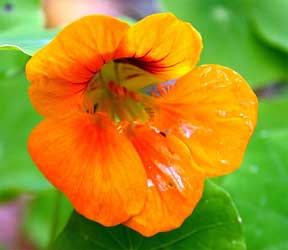Nasturtiums splash their golds, tangerines and maroons through our gardens and add bright patches of color to our flower bowls. All of us know and most of us delight in growing tropaeolum, which comes in a wide range of colors and in either dwarf or climbing varieties. A wealth of decorative color, however, is not the only gift of these sun-loving, long-spurred flowers native to the Americas. Their crisp, flat, roundish leaves and the unopened buds and seed pods can add lettuce-like freshness and spicy flavor to a wide variety of dishes… salads, soups, omelets, French dressings and sauces all through a long growing season.

President Eisenhower is said to have added a few shredded nasturtium leaves to his deliciously flavored vegetable-beef soup. We have added them, also shredded, to other line herbs – chervil, summer savory, parsley, tarragon, basil and marjoram. The nasturtium lends piquancy to the blend of these Old World herbs. Nasturtium leaves may be used in a mixed salad. The leaves recall water cress in both taste and lasting crispness. They give tang and color to small party sandwiches of cream cheese; in heartier sandwiches, too, they may be used.
Like cress, the delicately veined leaves with their fresh, bright green are decorative as a garnish on cold meat platters and around fruit or vegetable salads. The vivid flowers add still more dramatic effect. With their sweet bit of nectar and pleasant, peppery flavor, the flowers, along with the leaves, may be eaten in salads.
Young flower buds and seed pods of nasturtiums, like those of broom, elder and marsh marigold, may be gathered when large and fully formed, though still green and not dry, and then pickled for use as capers. Prepare a mild brine of wine vinegar, whole cloves, and salt. Bring this liquor to a boil and pour it over the seeds. These pickled nasturtium “capers” may be substituted for the Mediterranean type (Capparis spinosa) in a variety of ways. One Herb grower suggests them instead of an onion or olive in a Martini cocktail.
The nasturtium plant, native to the New World and a comparative newcomer to our tables, lacks the old-time associations of better-known herbs. Are we less adventurous than our hypothetical ancestor who, centuries before the Classical Age of the Greeks, first bit into the spicy green of parsley?
